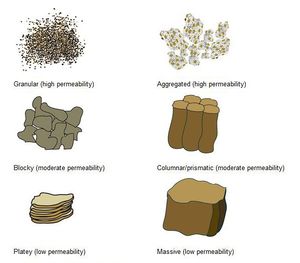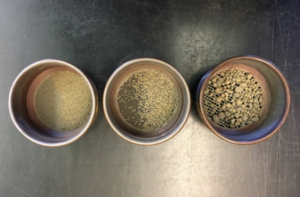
Difference between revisions of "Soil physical properties and processes"
m (→Soil structure) |
m (→Soil structure) |
||
| Line 39: | Line 39: | ||
==Soil structure== | ==Soil structure== | ||
[[File:Soil structure 2.jpg|300px|thumb|alt=image soil structure|<font size=3>Types of soil structure. Image from [https://www.deeproot.com/blog/blog-entries/what-is-soil-structure-and-why-is-it-important Deeproot]</font size>]] | [[File:Soil structure 2.jpg|300px|thumb|alt=image soil structure|<font size=3>Types of soil structure. Image from [https://www.deeproot.com/blog/blog-entries/what-is-soil-structure-and-why-is-it-important Deeproot]</font size>]] | ||
| + | |||
| + | [https://www.deeproot.com/blog/blog-entries/what-is-soil-structure-and-why-is-it-important This page] provides a nice overview and discussion of soil structure. | ||
Soil structure describes the arrangement and organization of soil particles in the soil, and the tendency of individual soil particles to bind together in aggregates. Aggregation affects water and air transport, which affects the movement of solutes and pollutants and affects biologic activity, including plant growth. | Soil structure describes the arrangement and organization of soil particles in the soil, and the tendency of individual soil particles to bind together in aggregates. Aggregation affects water and air transport, which affects the movement of solutes and pollutants and affects biologic activity, including plant growth. | ||
Revision as of 18:55, 16 June 2021
Contents
This page is in development
Physical properties of soil include color, texture, structure, porosity, density, consistence, and temperature. These properties affect processes such as infiltration, erosion, and biologic activity. These properties also affect suitability of soil for different uses, such as stormwater infiltration, subgrade for roads, and strength for building.
This page provides an overview of soil physical properties, processes they affect, and their affect on use, primarily for stormwater applications.
Soil texture
![image of soil texture triangle]](/images/thumb/7/79/Soil_texture_triangle.jpg/300px-Soil_texture_triangle.jpg)
Soil texture (such as loam, sandy loam or clay) refers to the proportion of sand, silt and clay sized particles that make up the mineral fraction of the soil. Soil texture is determined with one of the following methods.
- Mechanical sieving, if particle size > 0.05 mm
- Sedimentation if size < 0.05 mm. Sedimentation measures the settling rate of particles in liquid medium and relates this rate to the particle mass by use of the Stokes law. Forces acting on soil particle are gravitation, buoyancy and drag forces, all of which depend on particle size. Larger particles settle first. The particle mass is determined by density and particle size. Soils must be dispersed prior to measurement. Two methods are commonly used.
- Hydrometer method (see here for description)
- Pipette method (see this video for a description)
Other methods are used to determine texture, but these employ qualitative approaches. They include the feel method, ball and ribbon methos, and ball throwing method. These are described here. These methods may be satisfactory for some applications, such as determining if a soil may be suitable for infiltration, but they must be conducted by an experienced person, such as a professional soil scientist.
The following particle size distribution, based on sieve analysis, is commonly used to define soil particles.
- gravel > 2 mm
- sand 0.05 - 2 mm
- very coarse 1 - 2 mm
- coarse 0.5 - 1 mm
- medium 0.25 - 0.5 mm
- fine 0.1 - 0.25 mm
- very fine 0.05 - 0.1 mm
- silt 0.002 - 0.05 mm
- clay < 0.002 mm (< 2 micrometer)
Soil texture describes the distribution of these different size particles in a soil. There are twelve soils based on the distribution of sand, silt and clay. The adjacent image displays the soil texture triangle, which assigns soil type based on the distribution of sand, silt, and clay.
Texture affects many soil processes, including infiltration, drainage (water and air distribution), erosion, chemical processes, and biologic processes. These are discussed generally below.
- Sand: limited structural development, rapid infiltration, rapid drainage, low water holding capacity, leaching of minerals and organic material, reduced chemical and biological processing compared to soils with high clay content
- Silt: poor structural development, moderate infiltration rates, well drained, moderate rates of chemical and biological processing, easily eroded and compacted
- Clay: slow infiltration rates, poorly drained, high water holding capacity, high rates of chemical processing when not compacted or saturated, easily compacted
- Loam: since these are a mixture of sand, silt, and clay, these soils are generally well drained, have good water holding capacity, are chemically and biologically diverse and active
Soil structure

This page provides a nice overview and discussion of soil structure.
Soil structure describes the arrangement and organization of soil particles in the soil, and the tendency of individual soil particles to bind together in aggregates. Aggregation affects water and air transport, which affects the movement of solutes and pollutants and affects biologic activity, including plant growth.
Structure development is influenced by
- the amount and type of clay, as well as the exchangeable ions on the clay;
- the amount and type of organic matter, which provides food for soil fungi and bacteria and their secretion of cementing agents (polysaccharides)
- the presence of cementing agents such as iron and aluminum oxides; and
- vegetation, which produces organic matter and binds soil particles together through rooting.
Soil structure is typically divided into one of the following groups.
- Granular – roughly spherical, like grape nuts. Usually 1-10 mm in diameter. Most common in A horizons, where plant roots, microorganisms, and sticky products of organic matter decomposition bind soil grains into granular aggregates
- Platy – flat peds that lie horizontally in the soil. Platy structure can be found in A, B and C horizons. It commonly occurs in an A horizon as the result of compaction.
- Blocky – roughly cube-shaped, with more or less flat surfaces. If edges and corners remain sharp, we call it angular blocky. If they are rounded, we call it subangular blocky. Sizes commonly range from 5-50 mm across. Blocky structures are typical of B horizons, especially those with a high clay content. They form by repeated expansion and contraction of clay minerals.
- Prismatic – larger, vertically elongated blocks, often with five sides. Sizes are commonly 10-100mm across. Prismatic structures commonly occur in fragipans.
- Columnar – the units are similar to prisms and are bounded by flat or slightly rounded vertical faces. The tops of columns, in contrast to those of prisms, are very distinct and normally rounded.
